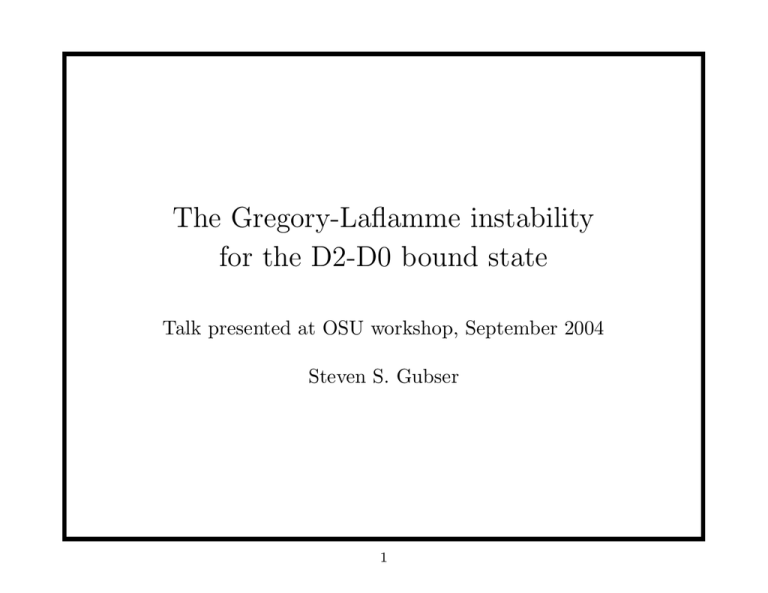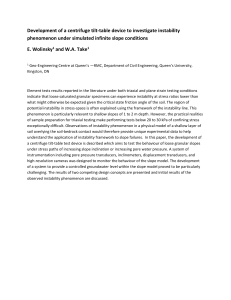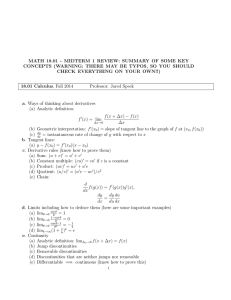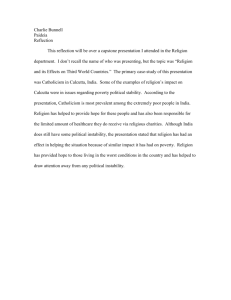The Gregory-Laflamme instability for the D2-D0 bound state Steven S. Gubser
advertisement

The Gregory-Laflamme instability for the D2-D0 bound state Talk presented at OSU workshop, September 2004 Steven S. Gubser 1 Correlated stability conjecture (CSC) [Gubser-Mitra ’00]: • A Gregory-Laflamme (GL) instability arises precisely when there’s a thermodynamic instability. What’s a thermodynamic instability? • Say S = S(E, Q). 2 ∂ S/∂M 2 • Form H = ∂ 2 S/∂M ∂Q 2 ∂ S/∂M ∂Q . 2 2 ∂ S/∂Q • If H has a negative eigenvalue, there’s an instability. • A negative eigenvalue means you can gain S by redistributing E and/or Q non-uniformly. • GL instability does precisely this. 2 Two caveats: • You must be able to redistribute Q. Else exclude it from Hessian. – Example: N coincident D1’s. QD1 can’t be redistributed along the D1’s. – Example: array of D0’s, N per cm2 . QD0 can be redistributed, making array non-uniform. • Finite size effects could prevent a GL instability – Example: Black string on an S 1 of radius R has a GL instability only if R > rH (up to an O(1) factor). – Example: Black hole in 4-d has a finite size horizon: stable despite thermodynamic instability, C < 0. 3 Why does it work? • GL noted that Sblackhole > Sblackstring for large mass. Saying H ≥ 0 is a local version of this. • GL instability is an infrared effect, so it makes sense for thermodynamics to dominate it. In practice... • Dispersion curve has ω 2 (k) < 0 for k < k∗ (the unstable modes). • Simplest to look for the static perturbation at k = k∗ : fields ∼ cos kx for some x along the brane. 4 Understanding of GL seems still rather primitive! (Numerics always seems required). 1. Endpoint of evolution of unstable horizons not known. 2. Existence of instability checked only for simple situations. Point 2 is where CSC helps. There’s even a proof of CSC if there are no Q’s [Reall ’02]. Let’s apply CSC to D2-D0 bound state and then check the results with numerics. This is the simplest case where you can’t guess the right answer in 5 minutes. 5 Some intuitions: • Highly non-extremal D2-D0 has a GL instability: charges don’t matter. p • For extremal D2-D0, τ = Q22 + Q20 , a convex function of Q0 . R So making Q0 non-uniform increases τ —not favored. • If Q0 Q2 , then D2 doesn’t matter. Continuous array of D0’s should have a GL instability [Aharony et al ’04]. • If Q0 Q2 , GL instability appears finitely far from extremality [Gubser-Ozakin ’03]. 6 1 The answer: CSC predicts GL instability in shaded region only. 0.8 0.6 Q0 M Numerics performed for the points indicated agree with this. Next 8 slides show how I got this. 0.4 0.2 0 0 0.2 7 0.4 Q2 M 0.6 0.8 1 SIIA 1 = 2 2κ Z d10 x √ G e−2φ 1 2 2 R + 4(∂φ) − H3 2 1 2 1 2 − F2 − F̃4 2 2 with F̃4 = F4 + A1 ∧ H3 ds2str = H −1/2 (−hdt2 + D(dx21 + dx22 )) + H 1/2 (1) 1 2 dr + r 2 dΩ26 h 1 r05 sinh2 α D = H =1+ r5 H −1 sin2 θ + cos2 θ 1 dt A1 = coth α sin θ 1 − H D dt ∧ dx1 ∧ dx2 A3 = coth α sec θ 1 − H D dx1 ∧ dx2 e2φ = H 1/2 D B2 = tan θ 1 − H 8 r05 h=1− 5 r Thermodynamics: V 2 Ω6 5 2 r (6 + 5 sinh α) 0 2 2κ 2πV2 Ω6 6 5 S= r0 cosh α T = 2 4πr0 cosh α κ M= µ2 = µ cos θ µ = tanh α Q2 = Q cos θ Q= µ0 = µ sin θ (2) Q0 = Q sin θ 5V2 Ω6 5 r0 sinh α cosh α 2 2κ • Want S = S(M, Q0 , Q2 ). • Have S, M , Q0 , Q2 in terms of r0 , α, θ. |∂(y1 , . . . , ŷi , f, . . . , yn )/∂(x1 , . . . , xn )| ∂f = . • Use ∂yi yj |∂(y1 , . . . , yn )/∂(x1 , . . . , xn )| 9 Boundary of stability (the red line) is where det H2×2 = 0. 2 × 2 means we exclude Q2 . Get √ csch α = 3 cos θ . (3) The plot was in terms of Q0 /M = 5 sin θ sinh 2α/(7 + 4 cosh 2α) Q2 /M = 5 cos θ sinh 2α/(7 + 4 cosh 2α) (4) with lines of constant α shown. Reall’s proof of CSC is for no Q’s. Hopefully extendable. Following analysis may help pave the way. 10 We seek a static, non-uniform solution. So KK reduce to only the (x1 , r) = (xµ ) directions: ds2str = Gµν dxµ dxν − e2ϕ1 dt2 + e2ϕ2 dx22 + e2ϕ3 dΩ26 2 A1 = a1 + a0 dx + ã0 dt ... Gauge fields like a1 have no dynamics, but they do impose constraints. Suppose for example Z S[a1 , . . .] = L Z 1 ϕ e (f2 + q2 ) ∧ ∗(f2 + q2 ) + q0 f2 L= 2 πa ≡ ∗(f2 + q2 ) + q0 = const Z Ŝ[πa , . . .] = (L − πa f2 ) . Ŝ gives correct dynamics for fields other than a1 . 11 (5) (6) Some ghastly mess results for dynamics of Gµν , ϕ1 , ϕ2 , ϕ3 , ã0 , and the 2-d dilaton 1 (7) Φ = φ − (ϕ1 + ϕ2 + 6ϕ3 ) . 2 Schematically: G −1/2 L=e −2Φ R + 4(∂Φ) 2 1 − Gab (ϕ)∂ϕa ∂ϕb − V (ϕ) . 2 (8) : a conformal gauge. Write Gµν = e2σ Gbackground µν Then perturbations are expressed in terms of six scalars: (ϕa ) = (σ, Φ, ϕ1 , ϕ2 , ϕ3 , ã0 ) (9) (a few others, like a0 , decouple). Ansatz is ϕa = ϕabackground (r) + δϕa (r) cos kx1 . 12 (10) Rµν − 12 Gµν R = 0 imposes two 1st order gauge conditions on δϕa (r), plus the eom for δσ(r) (2nd order). So for 6 functions δϕa (r), we have 10 integration constants: 6 × 2 − 2 = 10. k is an 11th parameter. Fix these 11 parameters by • Normalizability at ∞. – Gives 6 conditions: think ϕ(rf ) = 0 for some big rf . • Regularity at the horizon. – Most naturally analyzed in Kruskal coords—haven’t done it. – r = r0 is a regular singular point of radial eoms. Allows a rough-and-ready analysis, dropping subdominant terms in eoms to obtain bc’s. – Gives 5 conditions, including δAt = 0 at horizon. 13 Upshot: solve (mostly) 2nd order diffEQ’s from r = r0 to r = ∞, subject to 5 bc’s at r = r0 and 6 at r = ∞. Suitable for a shooting algorithm: randomly fix 6 remaining parameters at r = r0 , integrate, check bc’s at r = ∞. 3 6 2 ∆Σ ∆Φ2 ∆F ∆Φ3 ∆Φ1 ∆a 0 4 2 1 2 3 4 -1 2 3 -2 4 5 -2 -3 -4 GL is present ∆Σ ∆Φ2 ∆F ∆Φ 3 ∆Φ1 ∆a 0 GL not present 14 5 Numerics is prelimary—why? • Analysis of bc’s at r = r0 was loose. • Setting six numerically computed functions of six variables to 0 is not trivial. • “Whiplash” effect—might find ϕa (rf ) = 0 as a result of competition between large solns. Z rf +δr X dr |ϕa (r)|2 . – Better to minimize rf −δr 15 a Non-commutative field theory at finite temperature: A famous fact [Maldacena-Russo ’99]: thermodynamics at leading order in large N is unaffected by non-commutativity. • Obvious: large N ↔ planar diagrams • Planar vacuum diagrams escape non-commutative phases. • True in supergravity: M , S, T are θ-independent. But there’s a catch: it was tacitly assumed that [x̃1 , x̃2 ] = iϑ = const. Roughly, ϑ ∝ Q0 , so if Q0 gets non-uniform, thermodynamic behavior is vastly different from the ϑ = 0 case. This happens if M/Q is big enough. Where is the transition to GL instability? 16 It happens very close to extremality, where C > 0. • So for 0 ≤ T < Tc , bound state is stable. • And for T > Tc , GL instability arises. √ • T = Tc is on the red curve, det H = 0, i.e. csch α = 3 cos θ. Unravel various definitions to find: • ϑ = 2πα0 tan θ α0 . • Tension at extremality from D2’s is 5Ω6 5 N2 Q2 = r sinh α cosh α cos θ = N τ = . (11) 2 D2 0 2 2 03/2 V2 2κ gs 4π α Find √ # ϑTc = (gs N2 )1/5 2πα ϑ 0 3/10 17 2 1 + O(α /ϑ ) . 02 Note √ ϑT → 0 in the NCFT limit where α0 ϑ. So NCFT description of D2-D0 is strictly a zero-temperature statement. For T > 0, ϑ = ϑ(t, ~x). Recall the seemingly innocuous rescaling of coords in NCFT: R 3 p • Eαβ = gαβ + Bαβ enters DBI action: S ∼ d ξ det Eαβ . • E αβ =G αβ ϑαβ + , and Gαβ is the open string metric. 0 2πα • (t̃, x̃1 , x̃2 ) = (t, x1 / cos θ, x2 / cos θ) are chosen so that Gα̃β̃ = ηαβ . Massless open strings propagate on null geodesics of Gαβ , which is to say at v = cos θ in the closed string metric gαβ . v 1: the bound state is soft and squishy. Extreme limit of only D0’s has no rigidity at all. That’s why GL comes in. 18 Some caveats: • I’m relying on CSC: numerics only two points (so far). • I’m using supergravity approximation, so it’s conceivable that some T > 0 giving a highly curved horizon avoids GL instability. • CSC as it stands doesn’t tell us k∗ or the typical |ω| of the unstable modes. • Closed strings decouple, right? Probably so, but there is an order of limits issue in discussing thermodynamics. 19 Conclusions: • Presence of a Gregory-Laflamme instability is dictated by (local) thermodynamic considerations: det H < 0. • Boundary of stability can be arbitrarily close to extremality. • Non-commutative field theory is a good description of D2-D0 only at T = 0 (or possibly T below what SUGRA can see). • Several types of “charge” may be redistributed: QD0 , angular momenta, etc. • Near det H = 0, evolution of GL probably slides us along the boundary of stability. May be easier to find the endpoint. • Many other systems to study (work in progress with J. Friess). 20 References • R. Gregory and R. Laflamme, “Black strings and p-branes are unstable,” Phys. Rev. Lett. 70 (1993) 2837–2840, hep-th/9301052. • R. Gregory and R. Laflamme, “The Instability of charged black strings and p-branes,” Nucl. Phys. B428 (1994) 399–434, hep-th/9404071. • S. S. Gubser and I. Mitra, “Instability of charged black holes in anti-de Sitter space,” hep-th/0009126. • S. S. Gubser and I. Mitra, “The evolution of unstable black holes in anti-de Sitter space,” JHEP 08 (2001) 018, hep-th/0011127. • O. Aharony, J. Marsano, S. Minwalla, and T. Wiseman, “Black hole - black string phase transitions in thermal 1+1 dimensional supersymmetric Yang-Mills theory on a circle,” hep-th/0406210. • S. S. Gubser and A. Ozakin, “Universality classes for horizon instabilities,” JHEP 05 (2003) 010, hep-th/0301002. • H. S. Reall, “Classical and thermodynamic stability of black branes,” Phys. Rev. D64 (2001) 044005, hep-th/0104071. • J. M. Maldacena and J. G. Russo, “Large N limit of non-commutative gauge theories,” JHEP 09 (1999) 025, hep-th/9908134. 21
![[These nine clues] are noteworthy not so much because they foretell](http://s3.studylib.net/store/data/007474937_1-e53aa8c533cc905a5dc2eeb5aef2d7bb-300x300.png)







